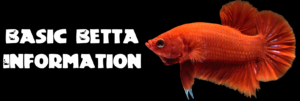 Welcome to the 4-H Betta Fish project, here is all the information you will need to know about keeping your Betta Fish. You click the bullet points below to jump to that section or continue to scroll down the page
Welcome to the 4-H Betta Fish project, here is all the information you will need to know about keeping your Betta Fish. You click the bullet points below to jump to that section or continue to scroll down the page
-
Montgomery County 4-H Fish Show & Tell Information Click: HERE
4-H Betta Fish Proejct Information
- Basic Betta Information
- Getting Started
- Fish Care

Life Span
3 to 5 years if kept and cared for properly.
Tank Size
- A 2.5-gallon tank is the recommended minimum but they are cable of living in small tanks
- Betta fish are known to jump, be sure your tank has a lid!
Equipment & Supplies
To maintain and care for your Betta fish you will need some essential equipment and supplies
- Fish Net
- Aquarium Filter
- Tap Water Conditioner
- Aquarium Syphon (for water changes)
- Bucket (optional for water changes)
- High-Quality Fish Food
Temperature
Betta fish are tropical fish with origins in Thailand. Betta thrives best in 76°F to 82°F. Purchasing a fish tank heater is recommended.
Water Quality
When adding tap water be sure to use a tap water conditioner to remove the harmful chlorine. If you choose not to use tap water and would like to purchase pre-conditioned water; RO/DI (Reverse Osmosis/Deionized) is considered the best type of water for fishkeeping because it is free of impurities and contaminants. Additionally, RO/DI water is also more stable and consistent than tap water. Because it is free of dissolved solids and contaminants, it is less likely to experience pH and hardness fluctuations, which can be stressful for fish. Some local fish stores will sell RO/DI water by the gallon, $0.30 to $0.50 per gallon. You can also purchase spring water from your local grocery store. Refrain from using distilled water, as it lacks the vital minerals your fish needs.
Water Quality Test
Conducting weekly water quality tests is recommended, you can purchase a freshwater quality test kit from most fish/pet stores. Be sure that your test kit includes an ammonia test. Optimal Water Quality Levels:
Test |
Optimal Level |
| Ph | 6.5 to 8 |
| Ammonia | 0 ppm |
| Nitrite (N02) | 0 ppm |
| Nitrate (N03) | <40 pmm |

Cycling Your Tank – Nitrogen Cycle
Before placing fish in your aquarium, you must cycle your tank. Check out the video below to better understand the process of cycling your tank
Two Methods for Cycling Your Tank
Fishless Cycle – This is the natural process of developing beneficial nitrifying bacteria to remove harmful ammonia and nitrites
- Timeline: 2 weeks to over a month depending on tank size
- Step 1 – Set up your tank and add water
- Step 2 – add fish food without any fish to introduce nitrogen
- Step 3 – Test water Daily and record your water quality level
- Step 4 – When your water quality levels are reached optimal level you can add fish (See table in the previous section)
Fish-In Cycling – This is the process of introducing existing beneficial nitrifying bacteria and fish into your tank to immediately start removing ammonia and nitrites.
- Timeline: <1 Day
- Only add 1 fish to begin, adding too many fish will overload your tank with ammonia
- Step 1 – Set up your tank and add water
- Step 2 – Introduce beneficial nitrifying bacteria. A few of my recommendations are listed below
- FritzZymne TurboStart
- Available at Fish Gallery
- Must be refrigerated
- Bio-Substrates
- Available at Petco and Amazon
- Sold in 5 lb bags
- FritzZymne TurboStart
- Step 3 – Test water Daily and record your water quality level to ensure the optimal water quality levels (See table in the previous section)
- *Optional but recommended – Add live plants to assist in absorbing ammonia and nitrogen compounds
For more detailed information on cycling your tank visit Fish Lab
Aquarium Decor
Adding decor and decorating is the most fun part of setting up a new aquarium!
Fake vs Real Plants
Fake Plants |
|
Pros |
Cons |
|
|
Live Plants |
|
Pros |
Cons |
|
|
For a complete list of low-light plants and their requirement visit Modest Fish
Gravel /Substrate
There are many options when it comes to gravel in terms of color and size, it is important to always wash your gravel before placing it into your aquarium. The only exception is when using bio-active grave/substrate.
If you are planning to incorporate live plants there are two options for the best results: nutrient-rich substrate or including root tabs with your aquarium gravel to provide food for your plants.
For more detailed information on a substrate for planted tanks visit Modest Fish
Tank Mates
Betta fish are very territorial fish, male Betta Fish MUST NOT be kept with other Betta Fish. Female Betta fish can be kept together, in what is known as a sorority tank. It is highly important to introduce the females properly and have 5 or more females to avoid picking/fighting. You must also have a minimum of 20 gallons for 5 females and a large variety of plants to break lines of sight. Females from the same spawn have a high success of cohabitating together.
Depending on your individual Betta you can keep other types of freshwater species, you want to avoid bright-colored fish.
- Nerite Snails: They will help to keep the aquarium clean and eat algae that grow on the side of the glass. They will NOT reproduce in freshwater but will lay hard to remove eggs (brown dots)
- No minimum aquarium size required
- Ghost Shrimp: They are great at helping to keep the aquarium clean by eating some algae and leftover food that falls to the bottom. Ghost Shrimp are used as live food for other fish and are less expensive. It is recommended to purchase only one to see how your betta fish will respond to it. Not all betta fish will tolerate ghost shrimp, be aware a betta fish can kill ghost shrimp. It is recommended to provide some type of shelter/cover, java moss works great, in addition, java moss can be a food source for your ghost shrimp.
- 2.5 gallons or larger
- grows to 1.2 inches
- Neon Tetras: Just like ghost shrimp it depends on your Betta Fish. Neon Tetras are schooling fish and require 3 or more to be present in the tank
- 5 gallons or larger are required
- Pygmy Corydoras (Corys): Cory Catfish are great bottom feeders to help clean up any uneaten food. Corys are also schooling fish and require 3 or more to be present in the tank. As with the other species, how well your betta will get along solely depend on each individual betta fish.
- 5 gallons (3 Corys) or larger (3 + Corys)

Fish Food
There are many options for feeding your betta fish. Most betta fish will eat commercial-ready foods such as pellets, flakes, and granules. It is very important to never overfeed your betta fish, one or two times a day is more than enough. It is also recommended skip a day to assist with digestion (clean out day). Frozen food is also a great option, some recommended varieties include Bloodworms, Mysis Shrimp, and Brine Shrimp. It is important to note, commercial-ready food has been formulated to provide a complete and balanced diet.
Happy & Healthy Fish
It is important to watch and observe your betta fish daily to ensure they continue to be happy and healthy. Below are what to look for in normal healthy bettas
- Eating Well and Hungry
- New bettas may take a few days to eat as they settle into their new homes
- Activity Swimming
- Bright Colorations
- Unfrayed fins
Possible Healthy Issues
Every now and then you might find your betta fish is not “acting ” normal these are signs that your betta fish is not feeling well. Here are some signs to look for:
- No interested in food
- Cloudy eyes
- Enlarged eye (p0p eye)
- Pinecone scales (elevated scales)
- Bloating or Dropsy
- Weight Loss
- Torn, loss of, or fraying fins
- White Spots coving the body (ICK)
- Lack of Energy
Daily Care
- Feeding your fish high-quality betta fish food
- Noting if all the equipment is working properly (heaters and filter are working)
- Check the water temperature and make sure it remains within the appropriate range of 78 to 82 degrees Fahrenheit.
- **For newly cycled/ing tanks, you will want to check water parameters daily
Weekly Care
- Test for water quality
- For tanks that are 2.5-gallon or less, test twice a week
- Perform Water Changes, every 1 to 2 weeks.
- If changing weekly, do a 10% water change
- If changing every 2 weeks, do a 25% water change
Monthly
- Change or clean your filter
- Use a water Syphon to clean gravel
- Do not use s Syphon with nutrient-rich substrates
 Montgomery County 4-H
Montgomery County 4-H